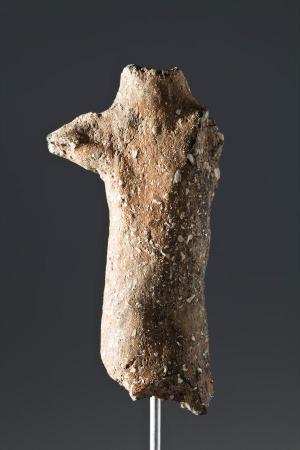Source - http://www.sciencedaily.com/releases/2012/10/121026084641.htm?utm_source=feedburner&utm_medium=feed&utm_campaign=Feed%3A+sciencedaily%2Ffossils_ruins%2Farchaeology+%28ScienceDaily%3A+Fossils+%26+Ruins+News+--+Archaeology%29
In the course of the excavation process in Can Sadurní cave (Begues), members of the Col-lectiu per la Investigación de la Prehistòria i l'Arqueologia del Garraf-Ordal (CIPAG), together with the University of Barcelona Seminar of Studies and Prehistoric Research (SERP), found the torso, with one complete arm and the initial part of the other, of a human figurine made of pottery. Its chronostratigraphic unit makes it, until now, the most ancient human figurine of the Prehistory in Catalonia; it is dated 6500 years ago.

The figurine is dated 6500 years ago and named “l‘Encantat de Begues”. (Credit: Image courtesy of Universidad de Barcelona)
The figurine, which is also the most ancient one found in the Iberian Peninsula, is an important indicator of the relevance that Can Sadurní might have had as a meeting point for the inhabitants of the closest areas during the Neolithic Age. This is not the first discovery that has been made in the cave, where the CIPAG researchers have been working for 34 years, and where the most ancient evidence of production and consumption of beer were previously identified. These discoveries point that Can Sadurní might have hosted some feasts, in which rare products might have been consumed. Moreover, other rituals with a mark symbolic nature might have been hosted there, any kind of crucial celebration to bring together groups scattered around the area and to ensure their economical, ideological and sexual reproduction.
The figurine matches with the beginnings of the Middle Neolithic, exactly the discovery has been made in the layer 11 (post cardial Middle Neolithic 1a), on its contact with the layer 11b (post cardial Early Neolithic 0). The figurine, only found until now its torso, its neck and its right arm, represents a human figure, probably a male one. The preserved fragment is 8 cm height, 1.90 cm thick and its width depends on the point from which we measure: 2.5 cm from its waist, 4 cm from its chest (if we only take into account the preserved arm), and about 5.5 cm on the same point, but we imagine both arms stretched out. The development of the rest of the body make think about a 16-18 cm height figurine.
Although it is impossible to notice them clearly to the naked eye, when the figurine is observed with grazing light two different lines can be noticed; they could be carvings that seem to reproduce some elements of clothing and ornaments. In fact, this kind of images used to be dressed up as humans and they do not show clearly sexual attributes, so normally the only element that allows to know the sex of the figure are breasts. In the case of Begues discovery, the absence of female breasts makes think that probably it is a male figurine. This male attribution means a novelty in the Iberian Peninsula because, up to now, more than the 80 % of similar Mediterranean and European representations are female ones.
The existence of a left arm is quite obvious because of the loosening fracture observed on the opposite side. It is hoped that this arm will be found in future excavations. Both arms are holed vertically. This feature indicates that the original position that the artisan imagined was the one of a figurine hanged from a cord or a leather strap. The cord might have been used in order to hang the figurine on a person's neck or on a site inside the cave. The figurine's neck is nearly all preserved and, as most of that time figurines, it is possible that the head was mobile and interchangeable, in order to fit it into the neck's hole.
Some examples of detached heads made of stone, terracotta or pottery have been found in sites of Neolithic Balkan and West Mediterranean cultures. A great number of researchers believe that these heads were interchangeable and, in many cases, made of wood, fact which explains why they have not been found.
A careful observation allows identifying the figurine's breast and back: on its back there is a central and vertical depression which marks its spine and shoulders. The position of the longitudinal section of the right arm indicates that the arms are stretched out, in a reception attitude. In addition, pelvic area has an angle that is less than 180º between the waist and the beginning of the lower limbs what makes think that the figurine was in a sitting down position or with the legs bended. It is unknown how the legs end but probably they do in flat feet, as it happens in a great number of figurines found from France to Near East, going through Italy, the Balkans and Anatolia. We hope that next excavation works document other fragments of the figurine to better understand the whole artefact.
All the know factors show that the figurine has a great symbolic and spiritual value. Generally, literature about this kind of images considers them to be images with divine attributes. To sum up, all its characteristics points towards what, in prehistory, can be defined as an idol. Researchers took into account this magical religious component, and the fact that traditionally Begues inhabitants have always received the nickname Els Encantats (the enchanted), in order to name the figurine as el Encantat de Begues.
Can Sadurní excavations are with the project "La prehistòria al sud-est del Llobregat. De la costa al massís del Garraf-Ordal," coordinated by the professor at the UB Department of Prehistory, Ancient History and Archaeology, Josep Maria Fullola, and the prehistorian and archaeologist Manuel Edo, the CIPAG president. The excavations, led by the researchers Manuel Edo and Ferran Antolín, are supported by the Begues Town Council, the Culture Department at the Government of Catalonia and the Centre d'Estudis Beguetans, as well as by other organizations and local enterprises, such as the caves Montau of Sadurní, where the cave and Can Sadurní masia are located.